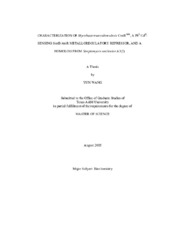| dc.contributor.advisor | Giedroc, David P. | |
| dc.creator | Wang, Yun | |
| dc.date.accessioned | 2006-10-30T23:32:44Z | |
| dc.date.available | 2006-10-30T23:32:44Z | |
| dc.date.created | 2005-08 | |
| dc.date.issued | 2006-10-30 | |
| dc.identifier.uri | https://hdl.handle.net/1969.1/4406 | |
| dc.description.abstract | The SmtB/ArsR family of prokaryotic metalloregulators are winged-helix
transcriptional repressors that collectively provide resistance to a wide range of both
biologically required and toxic heavy metal ions. CmtRMtb is a recently described
CdII/PbII regulator expressed in M. tuberculosis that is structurally distinct from the wellcharacterized
SmtB/ArsR CdII/PbII sensor, S. aureus plasmid pI258-encoded CadC. From
functional analyses and a multiple sequence alignment of CmtR homologs, CmtRMtb is
proposed to bind PbII and CdII via coordination by Cys57, Cys61 and Cys102 [Cavet et
al. (2003) J. Biol. Chem. 278, 44560-44566]. To better understand the mechanism how
CmtRMtb utilizes specific metal ions to perform transcriptional repressor function, both
CmtRMtb and its homolog in S. coelicolor A3(2) (CmtRSc) were studied. We establish
here that both wild-type and C102S CmtRMtb are homodimers and bind CdII and PbII via
formation of cysteine thiolate-rich coordination bonds. UV-Vis optical spectroscopy and
113Cd NMR spectroscopy (δ=480 ppm) suggest two or three thiolate donors, while 111mCd
perturbed angular correlation (PAC) spectroscopy establish an unusual trigonal
pyramidal coordination eometry. C102S CmtRMtb binds CdII and ZnII with only ≈ 10-20 fold lower affinity relative to wild-type CmtRMtb, but ≈ 100-1000-fold lower for PbII.
Quantitative investigation of CmtR-cmt O/P binding equilibria using fluorescence
anisotropy reveals that Cys57 and Cys61 anchor the coordination complex with Cys102
functioning as a key allosteric ligand, while playing only an accessory role in stabilizing
the metal complex in the free protein. Similar metal titration experiments were carried
out with a putative CmtR homolog from S. coelicolor A3(2) (CmtRSc) and a double
cysteine substitution mutant C110G/C111S CmtRSc. The implications of these findings
on the evolution of distinct metal sensing sites in a family of homologous proteins are
discussed. | en |
| dc.format.extent | 4790568 bytes | en |
| dc.format.medium | electronic | en |
| dc.format.mimetype | application/pdf | |
| dc.language.iso | en_US | |
| dc.publisher | Texas A&M University | |
| dc.subject | CmtR_Mtb | en |
| dc.subject | SmtB/ArsR | en |
| dc.subject | metalloregulatory repressor | en |
| dc.title | Characterization of Mycobacterium tuberculosis CmtR_Mtb, a Pb(ii)/Cd(ii)-sensing SmtB/ArsR metalloregulatory repressor, and a homolog from S. coelicolor A3(2) | en |
| dc.type | Book | en |
| dc.type | Thesis | en |
| thesis.degree.department | Biochemistry and Biophysics | en |
| thesis.degree.discipline | Biochemistry | en |
| thesis.degree.grantor | Texas A&M University | en |
| thesis.degree.name | Master of Science | en |
| thesis.degree.level | Masters | en |
| dc.contributor.committeeMember | Lindahl, Paul A. | |
| dc.contributor.committeeMember | Peterson, David O | |
| dc.contributor.committeeMember | Scholtz, J. Matin | |
| dc.type.genre | Electronic Thesis | en |
| dc.type.material | text | en |
| dc.format.digitalOrigin | born digital | en |


